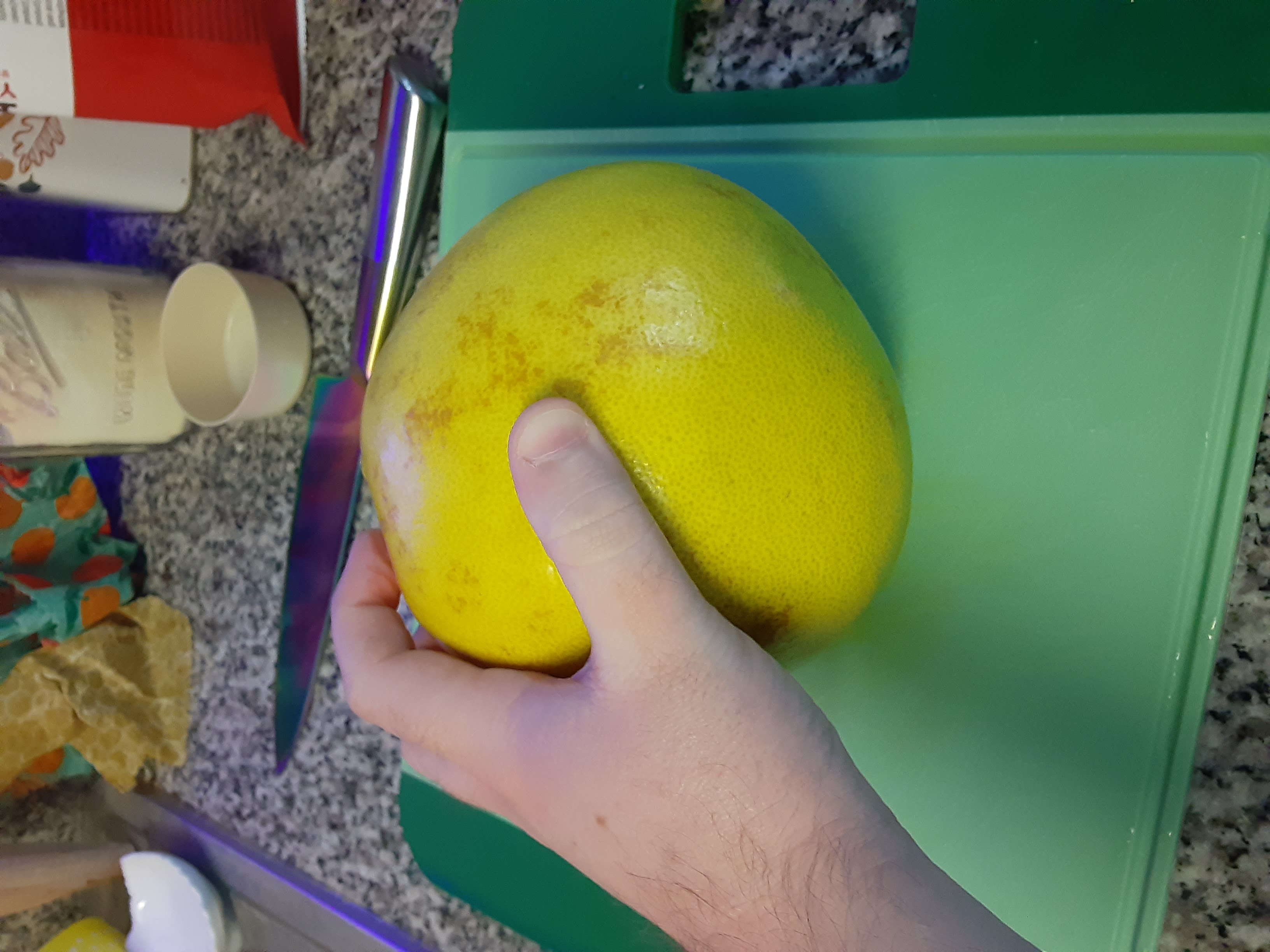
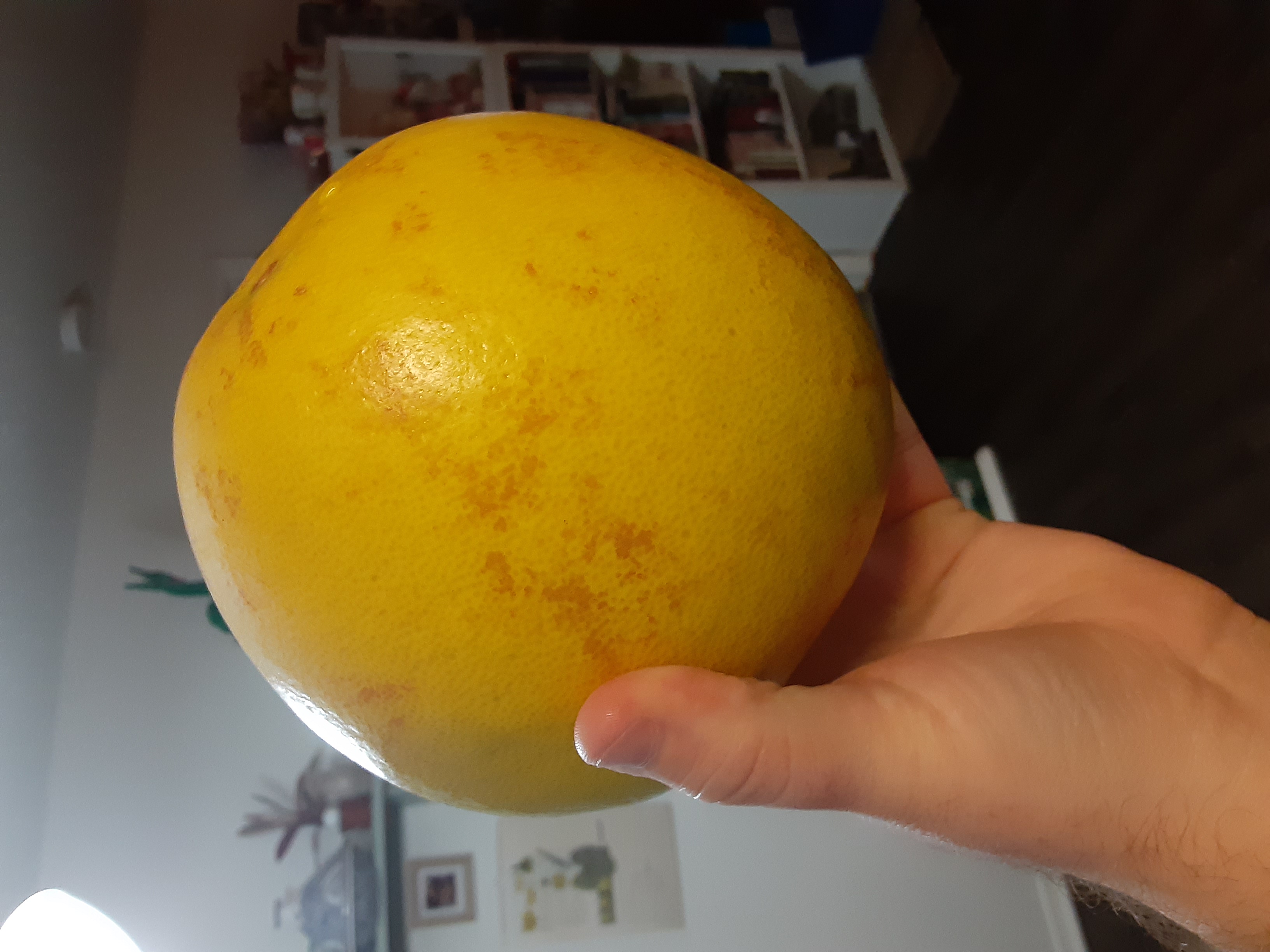


None of these observations are dated, but I've listed them roughly in the order that I tried the fruit in question. Whereever possible, I've made recommendations for people who want to find and eat their own strange fruits, as well as tasting notes to the best of my ability.

Pomelo is a citrus that holds the coolest possible scientific name: Citrus maxima! It's a naturally-occuring citrus, the ancestor of grapefruits, and gave grapefruit its ability to fuck up your medication.
This is a pretty easy fruit to find, though you might not have had a reason to grab one--it's awfully large for common citrus, and it's too big for a fun little snack. I think my pomelo came from Kroger (though it might have been the Asian grocery near my house), and you'll find a few of them at most large groceries in winter.
Jude and I split the pomelo I tried, which was a nice way to kick off my fruit journey. It's a big, pale-lime-colored fruit that's a gentle pinkish color inside--almost salmon colored, and less vibrant than grapefruit. It's also less tart than grapefruit, though it's more tart than ugli fruit (which I talk about further down--keep reading!). It's very nice as a side to a snack-like meal, and would be tasty in a tart.
I rate pomelo a B+. Give it a shot if you find one, especially if you're on the fence about grapefruit!




I've actually had lychee before, but I figured I'd have it again, just to have a chance to take notes on my feelings. Litchi chinensis is a south Chinese and Vietnamese fruit alone in its own taxon, though it's related to other soapberries like rambutan and longan. It has a reddish-pink exterior that looks horny and tough, but it's easily popped with a fingernail or a little pressure, and opens up to a milky-white fruit with a single large seed at the center.
Lychee is a common flavor in Asian snacks, so if you've had more than a few fruity treats from Japan, China, Vietnam, or Thailand, you've likely tasted them. They're hard to find at western shops, but you can usually find them in Asian groceries pretty easily. The harvest season in Florida seems to be early summer, but I think Hawaiian farmers harvest over winter, so check often! They're not too hard to get ahold of.
I had my lychees the day after I tried pomelo, and they were a little disappointing, since it was winter and they'd traveled quite a way to get to me. That said, they were still quite good! The fruits are easy enough to get to, albiet a little sticky to eat, and they're juicy and sweet with a slight floral scent. They have a texture that many people consider to be somewhat like eyeballs, and I unfortunately agree, so if you're texture-sensitive, you might skip this one.
Lychees are a favorite of mine, but I have to give them an A-, just because they're kind of a process to peel and eat. If you find a few, grab them and kick back on the couch to watch something fun while you eat them. You won't regret it!
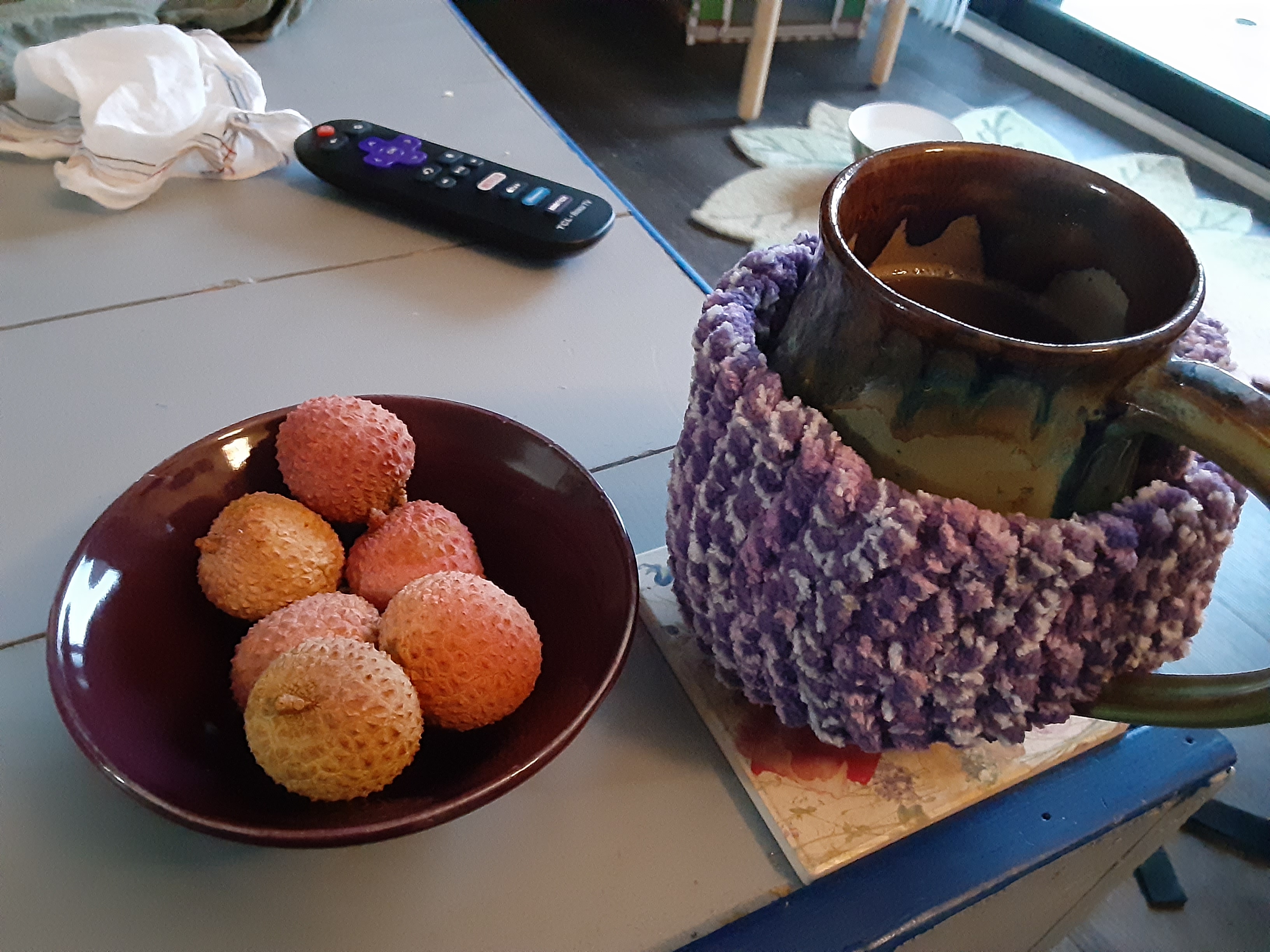







Formerly Citrus fortunella and now understood as Citrus hindsii, Citrus margarita and Citrus crassifolia, kumquats are a little bitty bite-sized citrus from south China that will apparently hybridize with about anything, readily so. They're very winter-hardy, so you can find them pretty often in the cold months. I found mine at the same Asian grocery I used to source most of my southeast Asian fruits!
Previously, I've had kumquat flavor, but I'd not had a chance to eat the fruit straight. There's an izakaya and boba shop near our local Aldi that sells a kumquat and lime drink that's really tart and tasty, so I was excited to eat a whole kumquat...
Damn, those things pack a punch! They're extremely tart and flavorful, which might make sense for its size, but I honestly didn't expect them to be SO intense. I'd say they're more flavorful than even grapefruits--aggressively tart and bright, and a little hard to eat quickly as a result. The skin is extremely thin, so you don't need to peel them to eat. Just pop one in your mouth!
Kumquats are delightful, but unfortunately I have to give them a B. They're just a little too tart for me to eat regularly. That said, they have an unparalleled flavor, and they'd be absolutely delight in any citrus dish that could benefit from a complex tartness. Really recommend giving this one a try if you've never had them!








Pineberries are a cultivar of strawberries, crossbred between two wild varieties called Fragaria chiloensis and Fragaria virginiana. They're only a couple decades old as a breed, and apparently taste like pineapple. They're not hypoallergenic that I know of (apparently white strawberries being hypoallergenic is a myth, though they seem to be slightly less intense than red strawberries), but are reportedly a good option for people who are allergic to pineapple. I'm not allergic to either pineapple or strawberries, but I don't agree with these being a strong alternative to pineapple.
Pineberries aren't uncommon or hard to grow, but they are a pretty new fruit. We found ours at Aldi, though they were about twice the price of regular strawberries. They have long growing seasons that differ between California and Florida growers, so while we found ours in winter, you'll probably have luck finding them year-round at any large or chain grocery, as long as you're not looking in the October lull between Florida and California harvest seasons.
As for taste, I'm a little disappointed. I didn't think pineberries were anything to write home about. I certainly didn't get any pineapple flavor--perhaps a little of a lighter taste than a good red strawberry--but it's basically a weirdly pretty, weirdly expensive strawberry. Not that I dislike it, but I don't see a reason why I'd go for pineberries over strawberries, unless I'm doing something artistic. Maybe a strawberry pie with red strawberry filling and some pineberry slices as garnish... mmm...
Just because pineberries are pretty indistinguishable(to me) from regular red strawberries, I rate them a C. They're definitely not bad! If you've got a more sensitive palate than me, you might appreciate them more. If you're a more average taster like me, skip these. They're not really worth the price of admission.

Cape gooseberries, while not real gooseberries, are a strange little South American fruit, nightshades called Physalis peruviana. It's Peruvian in origin, and has been known to grow in England, the Cape of Good Hope (South Africa), and Oceania. They're bright orange berries caped in a crispy green leaf-coat, which stays on the fruit right up until it's eaten.
Cape gooseberries normally get harvested in early fall, and they'll grow domestically in zones 5-7, though they're not a particularly popular crop. I got mine apparently from a greenhouse grower, since they were ripe in February. They can be hard to find, too. My local co-op stocked them, but I've never seen them available anywhere else, so these might be tough to get your hands on!
Eating Cape gooseberry was a polarizing experience. I thought they were lovely--juicy on the inside, toothsome and a tiny bit waxy on the outside, and mildly sweet with just enough tartness to balance it. Jude, on the other hand, hated them. They have a bursting quality that kind of reminds me of cherry tomatoes, and if you're sensitive to variations in texture, that in combination with its internal seeds might be too much for you.
I love Cape gooseberries, and ever since I ate mine, I've been looking out for more. I'd give them an A--they're a tiny bit involved to eat like soapberries, but only enough to make the eating feel ritualistic rather than tedious, and the flavor was a happy medium between familiar and new. If you find some, grab them! They might be pricy, but it's worth trying at least once.
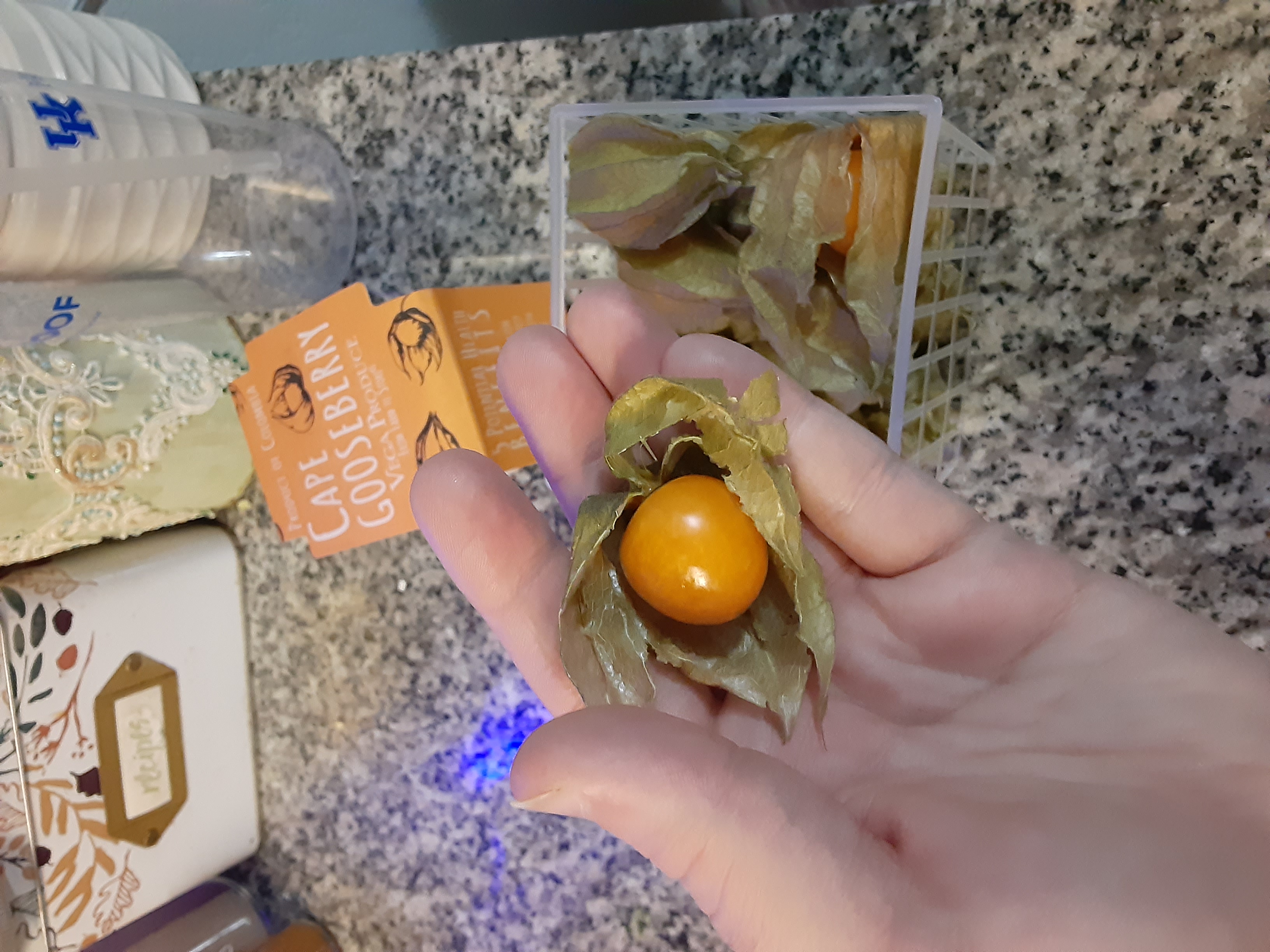






Dragonfruit, or pitaya, are fruits from the Stenocereus genus native to Mexico, though it's become quite popular in southeast Asia, especially Thailand. It's available at all but the smallest western groceries, plus most Asian shops, and is common as flavoring in sweets and juices. I've had dragonfruit before. I've had flavoring, fruit, and dragonfruit in other dishes. It's always been... bland. But I found a Tumblr post about finding GOOD dragonfruit, and I tried to give dragonfruit hunting a try.
According to this guide, you want a pink dragonfruit--they can also be white, which is the most common color, and yellow--one that's round rather than long, heavy for its size, and with short spikes. Then, you want to wait until the petals dry out and begin to turn brown at the tips.
I didn't have access to my dragonfruit guide when I was at my closest Asian grocery store, so I mostly looked for round, short-spiked fruit. I even found one with spikes that were going brown! Unfortunately, the brown bits were a little too extensive--this one was overripe, and the spike length didn't pan out to indicate pink fruit in this case.
You've likely had dragonfruit before, so you might not be learning anything new here. For the benefit of those who haven't, it's basically a slightly creamy, slightly sweet, mostly bland fruit with tiny black seeds that don't really interrupt the texture too much. It's uninteresting in both taste and texture. Mine, being overripe, was a little mushy and somewhat musky in that way fruits can get. I failed in my mission to find a good dragonfruit this time... perhaps I'll keep going.
This particular dragonfruit earns a D+. It's inoffensive on the whole, but so uninteresting that I don't know why I'd waste my time eating it when I could eat something cheaper, like cardboard or dryer lint.
Though, I am intrigued by the prospect of a good dragonfruit... perhaps I'll continue the hunt.
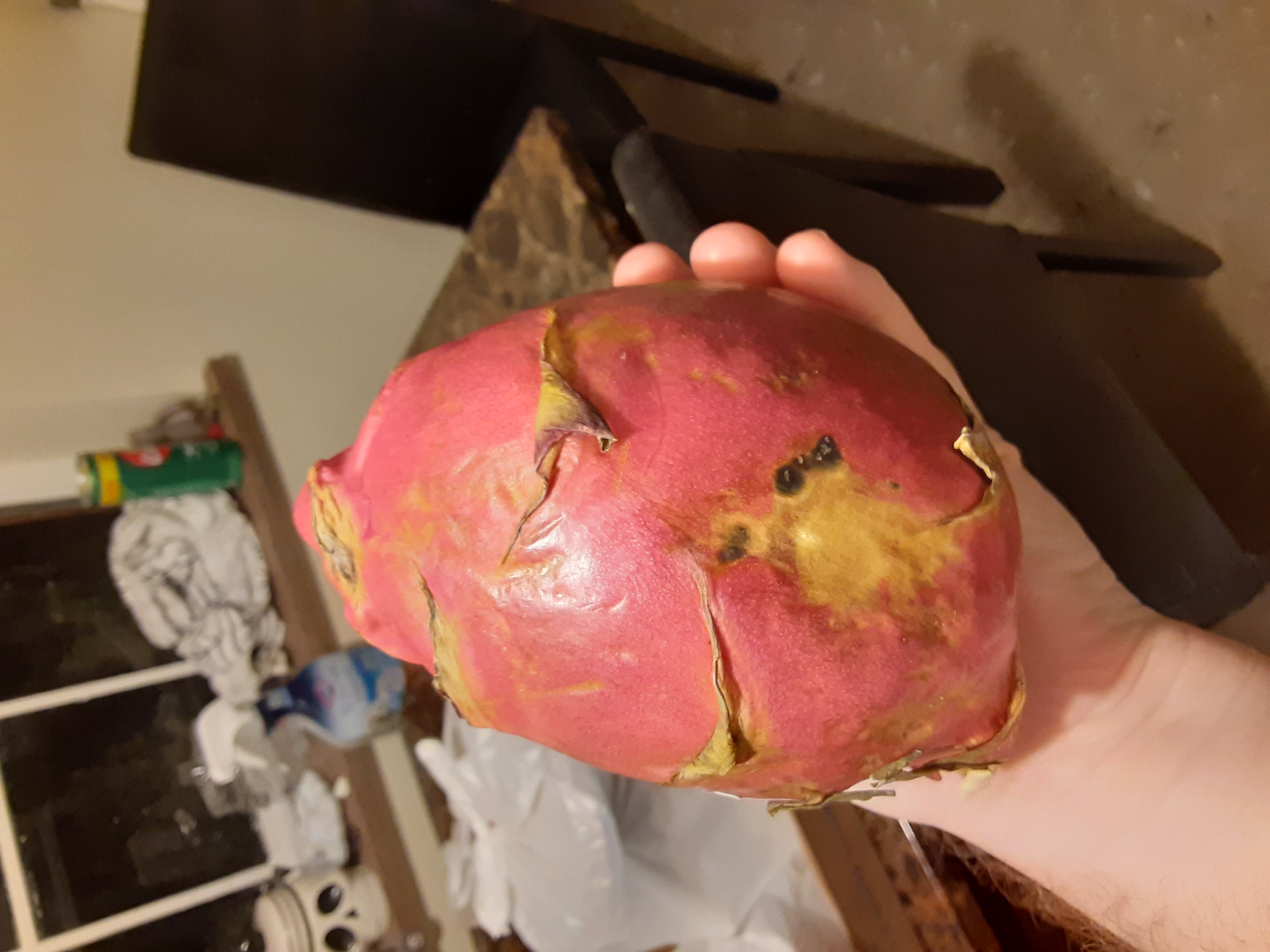













Coconut, a drupe known as Cocos nucifera to scientists, is a commonly-available fruit and very popular in sweets and baking. Young coconut, on the other hand, is somewhat uncommon, at least at mass-market stores. While a standard coconut is about a year old and fully mature, young coconuts--which are normally green with a thick, inedible outer shell--are harvested when they're roughly six or seven months old, and are usually cut down to size and given a distinct double-cone shape.
I didn't realize that young coconut was so different from mature coconut, but apparently it's a friend's favorite fruit, and one they haven't had for some time, so we grabbed one to share with them. They're relatively common at Asian stores of all kinds, and I've seen them at the co-op in town a couple of times, though they're hard to find at western grocery stores. Coconuts, at least in Florida, are harvested year-round, so young coconuts are in steady supply for the shops that carry them.
This fruit had more water than a mature coconut, but our friend's chosen opening method (hammer) didn't leave a lot left. The meat is what's really interesting here--it's very thin, milky, and has a jelly-like consistency. I found it sweeter than regular coconut meat, but pretty insubstantial.
My personal experience of young coconut was a B- experience. It was nice, honestly, but my friend's hammer-related opening method wasted the part that young coconuts are really known for: the milk. I'm eager to try this one a second time to see if the whole experience is better!
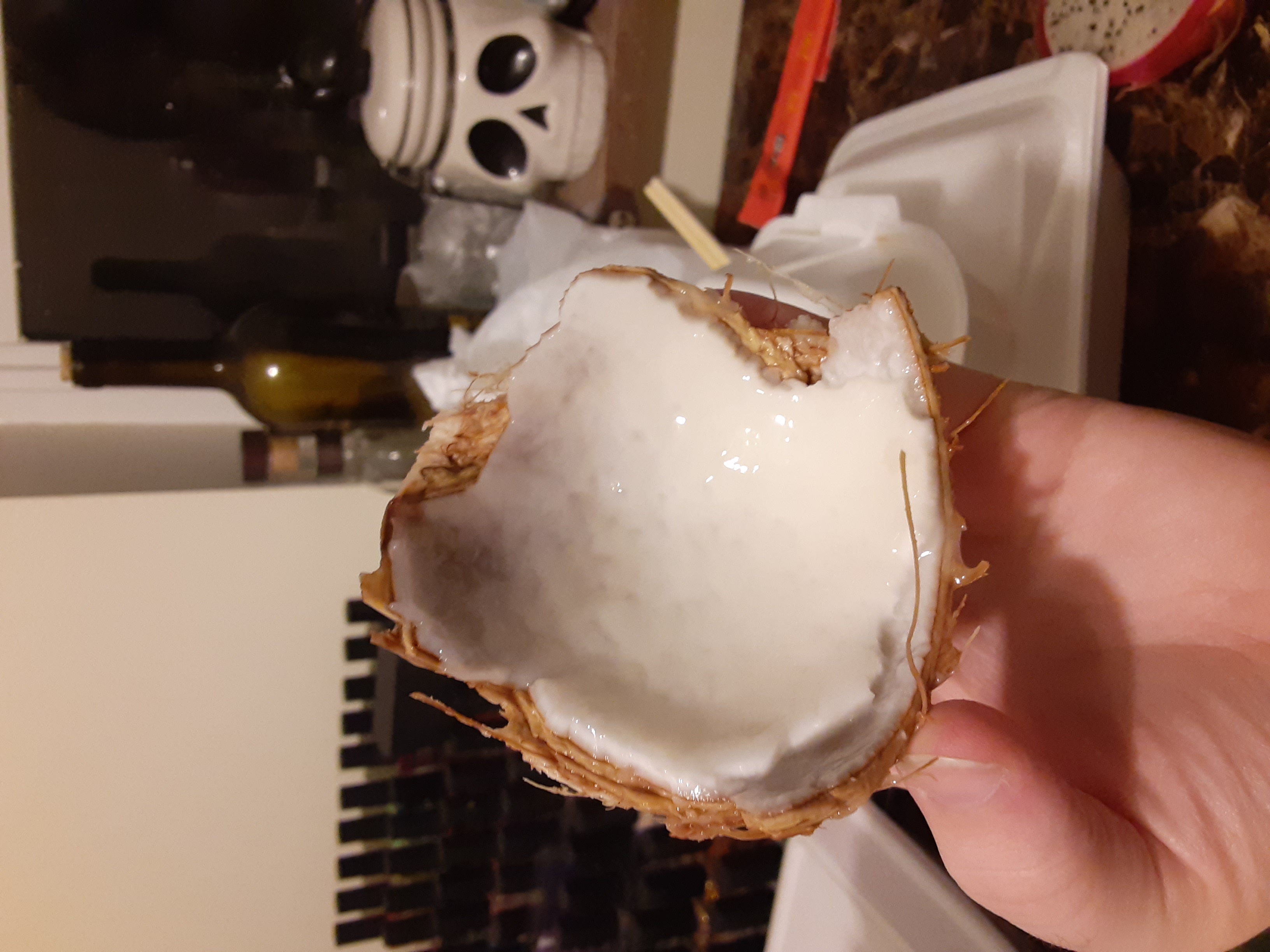


This fruit comes from Artocarpus heterophyllus, or the jack tree, which is native to several tropical regions and was first domesticated in India and southeast Asia. It's obviously related to other breadfruits, but is also a relative of figs and--surprisingly--mulberries, which are my childhood favorite foraging snack!
Jackfruit isn't terribly popular in the west, but it's known for its use as a meat substitute (via the underripe fruit--more on that later). It's not easy to find in standard groceries, but occasionally the Kroger near my house carries one or two. Most Indian and Asian shops will have a couple, though. Alternately, you can do what I did and buy canned jackfruit in brine or syrup; since this is a very large fruit, canned or frozen product might be ideal for your situation.
My experience with jackfruit was with canned product, which I was eager to try until I got it close to my face... What comes to mind is "chemical" or "briney," which could be a function of the processing and the fact that I bought by far the cheapest option available, but the description that comes to my heart is "tastes like tire." I was not a fan of ripe jackfruit, and I did not finish my portion. Jude wouldn't try it.
In the future, I'd like to try fresh jackfruit, just to see if that particular distributor's canning process was what made me dislike the fruit, but I'd be afraid to buy a jackfruit and waste most of it if I dislike it, since jackfruits are quite big. For now,I rate ripe jackfruit a solid D.
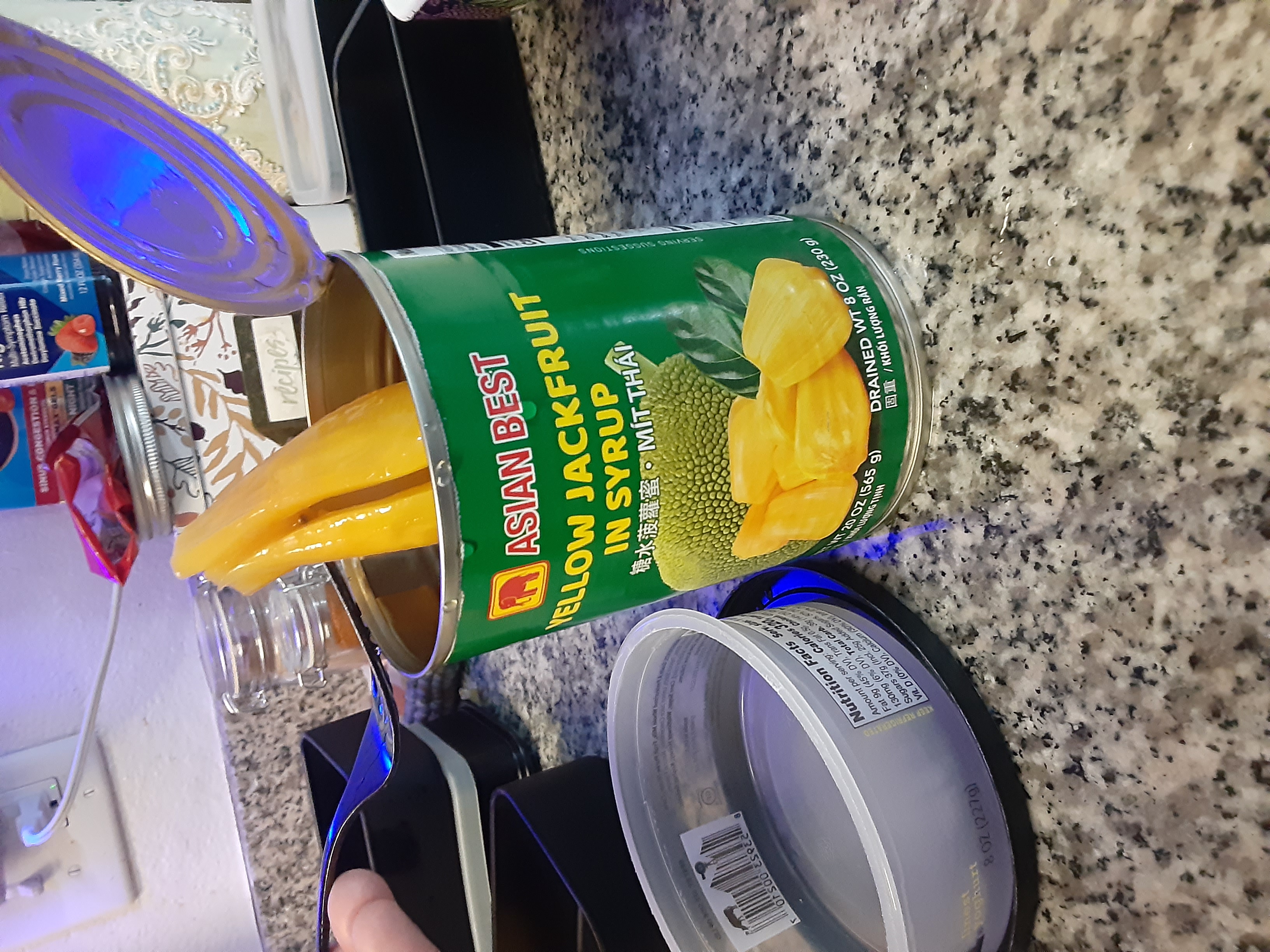








You know him. You dislike him. Jackfruit is mostly eaten ripe, as are most fruits, but vegetarians have been known to use underripe jackfruit as a meat substitute, particularly (at least, in the US) as a stand-in for pulled pork in barbeque recipes! I bought this in a can, but this time I sprung for a slightly nicer, water-packed option, which I cooked in barbeque sauce and then shredded for jackfruit barbeque, which went to a work potluck.
Underripe jackfruit isn't something I'd really want to eat straight, but it's not half bad in a barbeque dish! It doesn't really taste like pork, though the texture is right, and it's a little sweeter than I anticipated. I've made the recipe twice now, and I'd eat it again in the future. Underripe jackfruit is a B, but if your jackfruit sandwich has a nice slaw on it, it can have an A ;)






This was something I picked up without knowing anything about it! This was at the Asian grocery I go to, and the shopkeeper was too busy to tell me what it was. I did quite a bit of research (kind of hard to research a fruit based on its shape only), but it turns out I didn't need to look for Asian fruits. Lemon plums are from South America, and they're just your average plum with a little bit of a twist!
This fruit is a lovely red-orange, with a cute little peak on one end. It was perfectly ripe, with somewhat firm flesh but no crunch, a tight skin, and a floral, sweet taste with plenty of juice. I'd say it was a tiny bit brighter than your average plum, but it largely tasted just like your average purple plum.
I rate lemon plum a solid A! I love a plum anyway, and this cute little format is a great bonus without costing extra money. If you find some, grab a few and admire them while they ripen!













Longan (Dimocarpus longan) is another soapberry from Asia, producing little brown-skinned fruits alone on the end of each stick of a tree. It's a common fruit flavor in Asian cuisine, particularly in southeast Asia, and I found them in early spring at my local Asian market (they were a little early in the Florida growing season, I think, but they're normally harvested in mid-spring). If your market is like mine, they're probably sold on the stem. They're also sold canned in syrup by a number of Thai food producers, so if it's out of season, try it preserved.
Longan is an A- fruit for me. It's very tasty, and keeps pretty well (though, when one goes, they all go, and fast, so you should eat them within a week or two anyway). The only downside is that it's eating-intensive, with a large seed, sticky juice, and an inedible covering, so it's a little bit of a procedure to get at the meat. That said, the taste more than makes up for it (though lychee, which is a bit more floral, would win in a head-to-head contest... sorry, lychee).
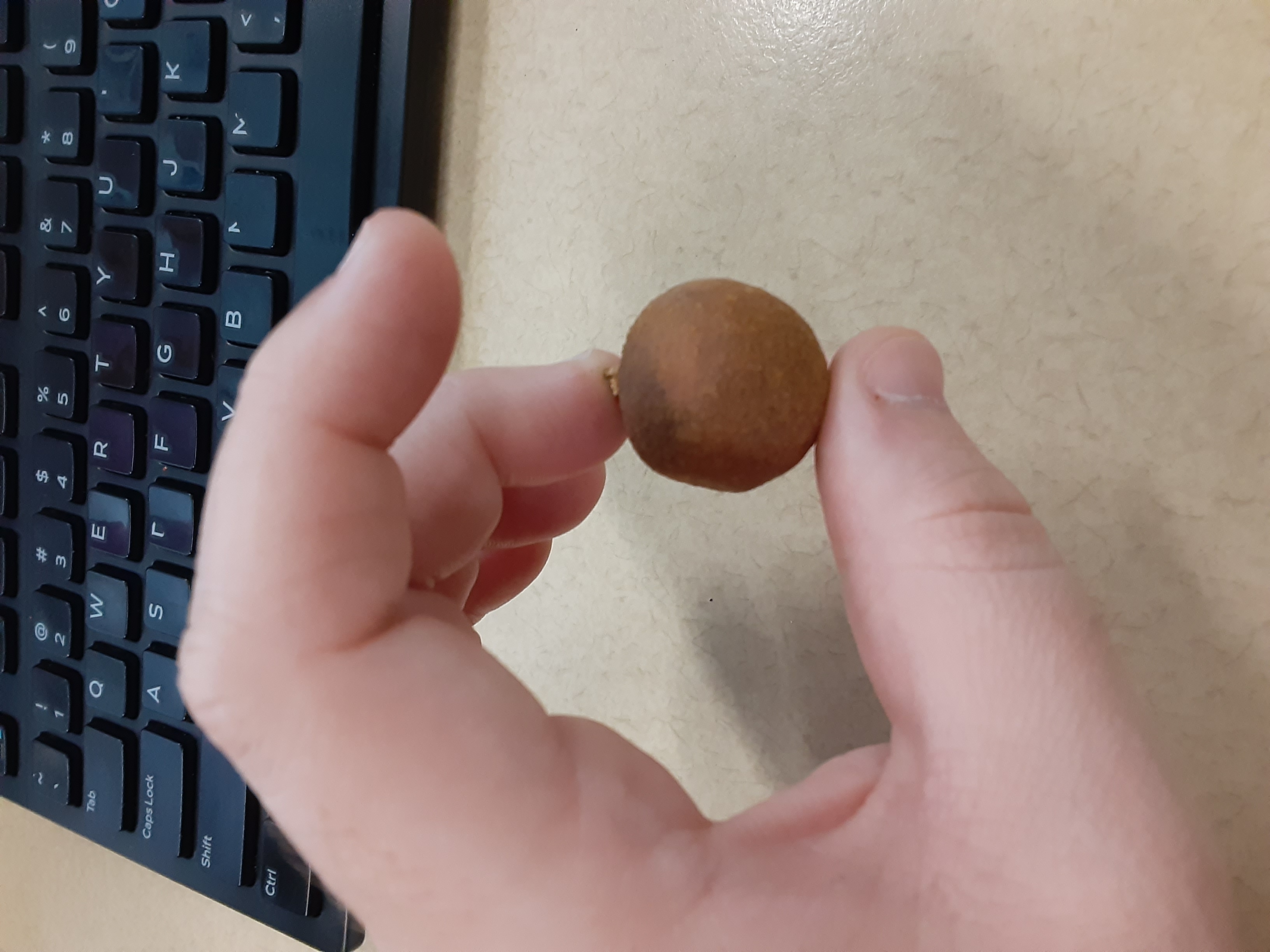







Ugli fruit (officially a hybrid of Citrus reticulata and Citrus paradisi, also known as the Jamaican tangelo) is a wildtype hybrid tangelo that arose in St. Ann Parish, Jamaica, in the 1910s. It's a wrinkly, oblong-ish green-orange monster of a fruit, around the size (or perhaps a little smaller) than your average grapefruit.
Surprisingly, the ugli fruit is less tart than I thought it would be! Based on its size and exterior, I expected something very sour like a grapefruit, but it's actually quite mild. It's definitely not as sweet as smaller, more common citrus fruits, but I enjoy that about it. It's very juicy and a little vegetal, and I want to use some of its juice in lemonade someday. However, while it's an interesting flavor, I don't think it's terribly strong or unique enough from other citrus to make it truly memorable.
Visually, the fruit is striking from the exterior--it's "ugly," sure, but in a kind of common way, and it's rather large, so it draws the eye. The sections are a lovely light orange color, and they look very pretty in cross section. The pith isn't very thick, and with the rough exterior, I'd be a little concerned about zesting the fruit for fear of ride-along contaminants.
Ugli fruit is available in winter and early spring, and it's marketed in the US by Cabel Hall Citrus, so it appears in supermarkets with relative frequency. Personally, I got a pretty large one for about $8 from a local co-op. Keep an eye out at bigger general groceries near the end of the cold months.
Ugli fruit was a lovely experience. I'd give it an A- overall, and I would try it again!
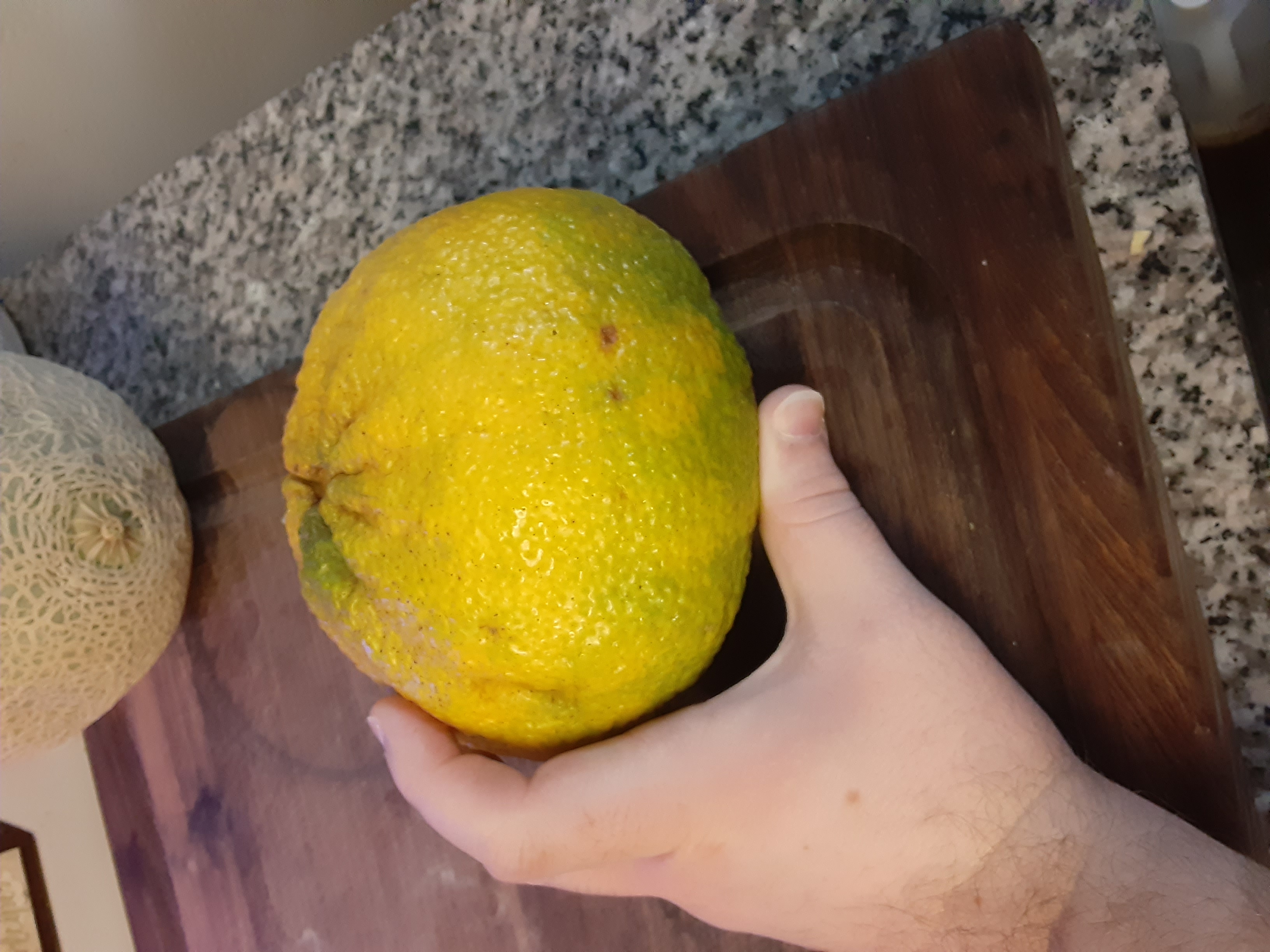
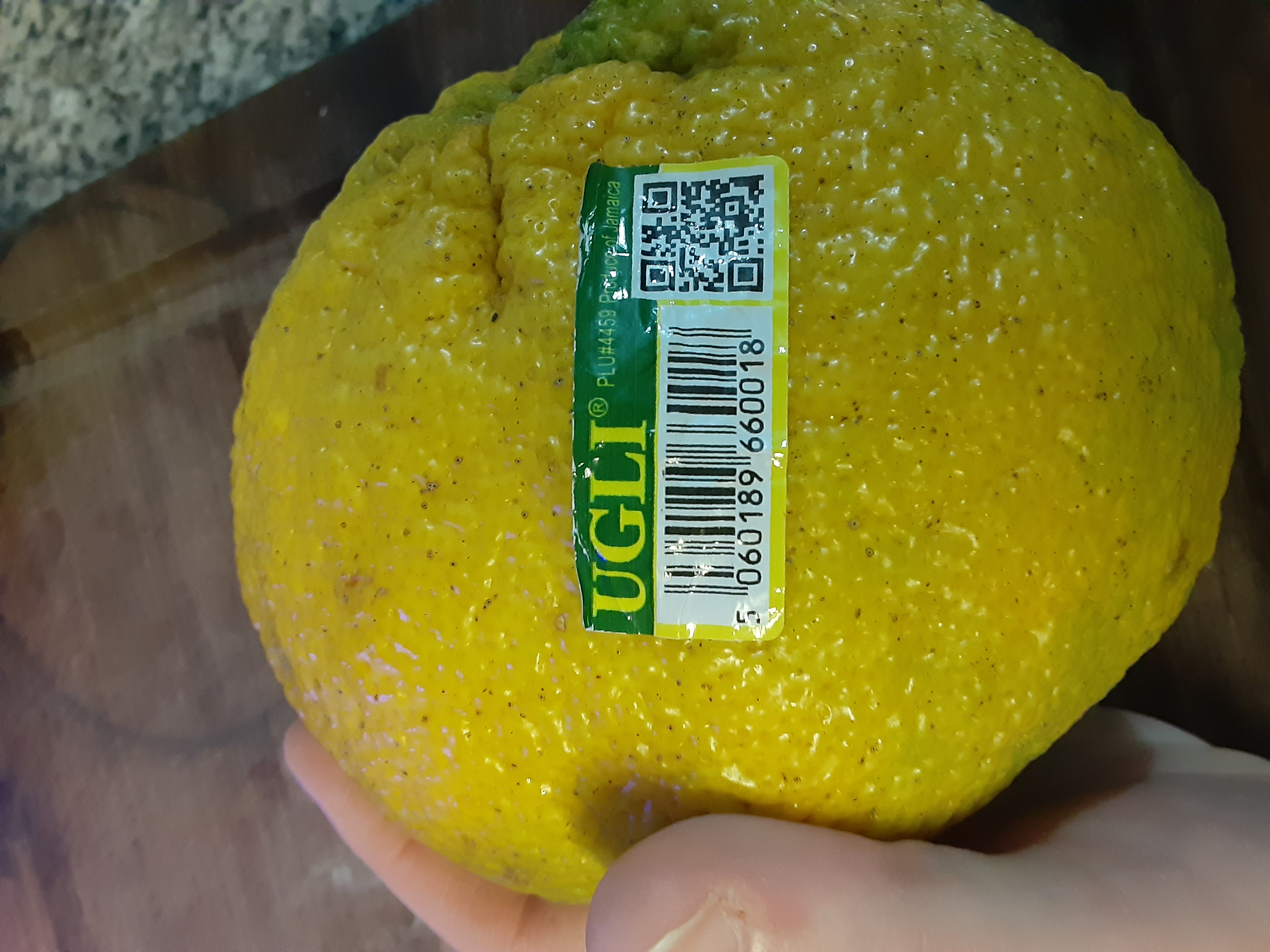
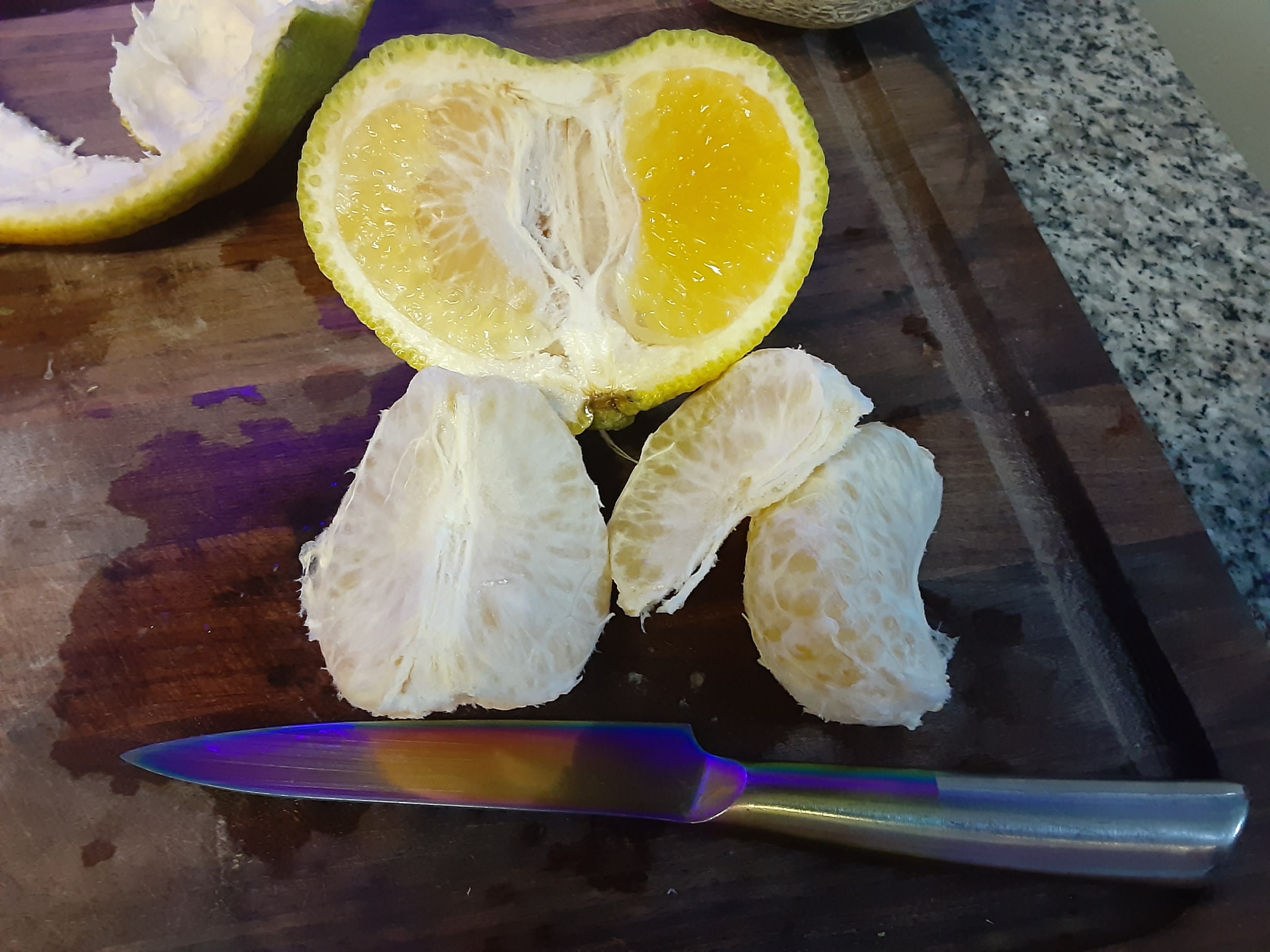









(The question mark here is because I'm not 100% sure that this was a cherimoya. It's possible it was a slightly different cultivar that's also called cherimoya, or that it was a sweetsop or soursop. Based on size, availability, and flavor, I'm pretty sure it was cherimoya, but it wasn't labeled, so...)
Annona cherimola, also called the custard apple, was first cultivated in central America. It's scaly, big, forest green, and kind of heart-shaped, with an off-white interior and big glossy black seeds. They can be grown in sunnier US states in early spring, though they grow in shade in Japan--I'm not sure what the growing season there is like, but perhaps it's a little later? We got our cherimoya near the end of the California growing season at the Asian grocery I usually find fruits at, and it ran me about $12 for a pound, which wasn't uncommon based on the other couple of times I've seen cherimoyas for sale.
Cherimoya was one of the fruits I was most hyped about eating. One of my managers at work made me promise to tell her if I got my hands on a cherimoya--apparently she'd been looking for one for years. Once I brought it in, she lit up and insisted on paying me a $10 finder's fee for half of the fruit (even though I bought it at the same Asian grocery store I get most of my exotic fruits at, only three miles away from our office!). It was like fulfilling an IRL fetch quest... very satisfying.
However, I was immediately a little worried about the cherimoya's taste. Jude tried it before I did, and he had an immediate disgust reaction. He felt it tasted pretty much like vomit! I've had a related fruit, pawpaw, in the past, though, so I was still heopful I'd like it. The taste I got was a very gentle, vanilla-like sensation, with a bit of citrus on the front and banana on the back. There's the tiniest note of pineapple in there, too, and the fruit tends to taste a little more like apple once it oxidizes. The texture is quite nice as well; creamy and semi-smooth, though rougher than pawpaw in my opinion. It's soft enough to eat with a spoon.
I still like pawpaw better, but I'd give cherimoya a hearty A-. It's just a little too sweet for my taste. That said, I can't recommend it enough! If you ever get a chance, grab a cherimoya and split it with a friend! I hear it's good in smoothies :)
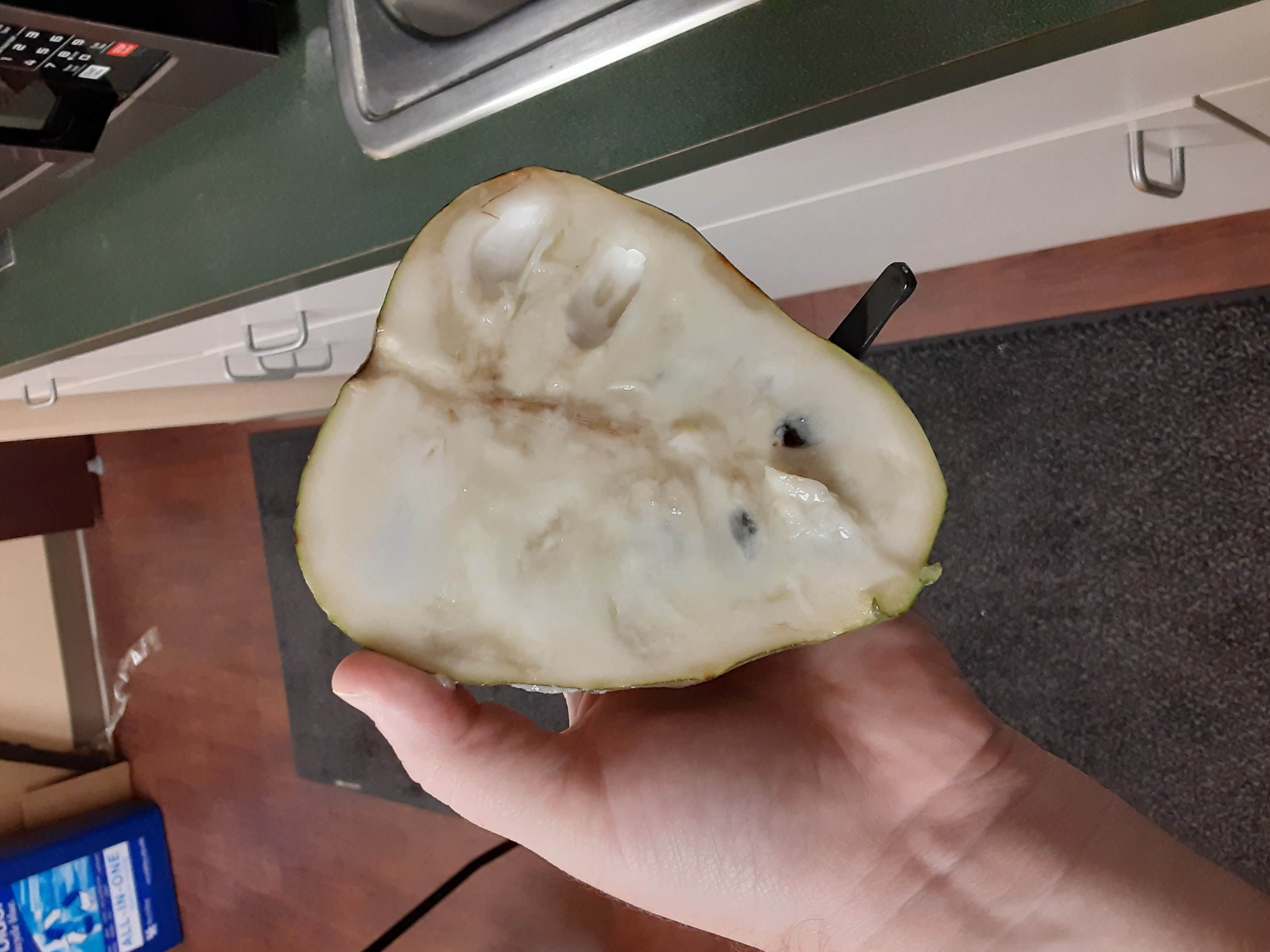









Over most of the summer, I wasn't able to eat any new fruits, largely because Jude and I were doing less grocery shopping during the middle of the CSA season (we had more than enough fresh produce to deal with!), but also because we're trying to save up to buy a house. Also, there was the issue of peaches. Namely, the volume of them we kept buying from the farmer's market. We're talking like, two or three pecks of peaches at a time, some of which were canned into jam and some of which were eaten ravenously by the fistful over the sink in our kitchen.
Anyway. The fruit journey restarted in late summer when a coworker of Jude's brought in some durian to share with the office. She called me over to try some, and I took a small amount. Our coworker admitted that she wasn't a huge fan of it as a child, but that she grew fond of it over time, and now craves it as an acquired taste. Personally, I didn't acquire the taste in a single bite, but...
Durian sure is an interesting fruit! It's actually a number of fruits from genus Duro, but we likely ate Duro zibenthinus, which is commonly found internationally. It's a rather large fruit (Wikipedia says 2-7 pounds, but I've frequently seen fruits that have to be upwards of 15 pounds) with a brown, spiked exterior. The inside fruit grows in creamy yellow lobes surrounded by white pith, but it's best known for its lingering smell--famously, several countries have banned durians from public transportation!
Before I ate the durian, it smelled like sauerkraut--not strongly, strangely enough, but it was a pervasive smell that stretched more than I expected it to--mixed with a little tropical sweetness and the slightest note of vaseline. It was a little sweet in taste, but had a pleasant, very meaty and consistent texture that I enjoyed quite a bit. That said, most of the taste was strongly like natural gas and petrolium products, so I didn't go back for a second bite.
Honestly, I wanted to like durian, though I knew I was unlikely to enjoy it (I already didn't like ripe jackfruit much). It was a C- at taste, but dropped to a D- for the lingering aftertaste that stuck around for upwards of 20 minutes, and reminded me vividly of the sensation of standing very close to an oil derrick for an extended time. I have a note in Discord that it "made the entire office smell vaguely unsafe," apparently. Not pleasant, unless you really like the smell of gas fumes. I might give it a shot again if I feel adventurous, but I probably won't.






Pawpaws (Asimina triloba) come from a tree native to the eastern US, and Kentucky is dead center in the tree's natural distribution range. They were traditionally popular in the region, both with native populations and settlers, but have declined in popularity in modern day, since they're very hard to commercialize (and still aren't available in stores thanks to their soft flesh and short hold time).
Jude and I were excited for pawpaw season, since we wanted to do some cooking experiments with them, and we jumped into action when our friend Cav mentioned a little-known grove of trees on the statehouse lawn. Sure enough, there were six full-size plants loaded with fruit, with a good deal more rotting on the ground! We grabbed a basketful in about 10 minutes time and were on our way. There's a really good chance these fruits were either KSU Atwood or KSU Benson, as the university that produced both cultivars (Kentucky State) sits a couple miles down the road from the statehouse. However, I'm more inclined to think they were wildtype fruit, since they were quite small, and since they tasted different than previous crops I've tasted.
I've had pawpaws before, and I've even talked about them on this page previously, but those experiences came from fruit sourced by foragers or farmers who brought their fruits to market in Lexington. This particular crop of pawpaws had fruit with a grainy quality that I didn't find in previous fruits, despite the signature custard-y, banana-y flavor I've enjoyed in the past. They smelled delightful, though! This particular crop of trees is a B- at best, a grade that (while it probably should be lower) pains me to give. Maybe when we buy a house, I'll get a farm cultivar and plant a tree in the yard...








Plantain is another fruit that I've technically had before, but it's been a very long time, so I figured I'd write about it so I remember it better in the future. These are members of genus Musa, which includes bananas--actually, culinary plantains are often really green, starchy bananas! I'm not entirely sure if we ate botanical true plantains or cooking bananas, but it doesn't matter too much. All culinary plantains are high-starch, low-sugar fruits that are served as staple foods in a number of tropical regions, often as a fried offering. I had mine two ways during a trip to a Honduran restaurant with friends: fried as an appetizer, and dried in strips as a chip under a topping, kind of like nachos.
It's really hard to rate plantains. It's like rating a potato--it's a wonderful staple, and makes a solid base for many foods, but on its own it struggles to outshine the standalone fruits. It lent a slightly sweet, comforting note to the dish that it supported, and (the fried version, at least) was nice and soft with a bit of natural carmelization. I'm inclined to give it a qualified A. It's a great fruit, but it doesn't serve the same purpose as many of the other fruits on this list. That said, it's an all-rounder and we should applaud her for her hard work!
I also had another uncommon-for-the-US dish at the Honduran restaurant, though it's a veggie and doesn't get its own place on this fruity list. Yuca, also called cassava or mainoc, is the tuber of Manihot esculenta, also used as a staple crop in tropical regions. This was also hard to evaluate, as it was part of a meal (and served with a spicy sauce that I couldn't quite tolerate), but it was essentially a sweeter, firm, potato-like veggie that took a beautiful fried exterior. The best taste I got of it definitely drove home that it was sweeter than other tubers I'm used to, but not unpleasantly. That said, I refuse to rate it on grounds that I had so little and that it's not a fruit. But I do look forward to eating it again, hopefully with less spicy sauce!








This was not a fruit I expected to get my hands on--I actually wasn't even aware of it! A work friend had found a Hami melon for sale at Costco and, knowing my proclivity for weird fruit, brought me a slice.
The Hami melon--a variant of Cucumis melo--is actually a group of sweet melons hailing from the Xinjiang Uygur Autonomous Region, in the northwest of China. They're also called snow melons. It's no wonder I've never seen one, since my go-to store serves a population further south! The one my coworker brought in had a honeydew-like exterior before it was cut, with the signature crackling texture, though it was more oblong in shape. Its flesh, which was all I personally saw, was a pale orange, and quite crisp.
The fruit had no scent--I'm not sure if that was intrinsic or if the whole fruit had smelled like something before it was sliced. It tasted very much like honeydew, with a gentle floral note and an unchallenging sweetness, but its texture intrigued me. It felt more like biting into a very firm watermelon, or perhaps some kind of vegetable. It wasn't tough by any means, but much crisper than any melon I've had before, and had a very high water content. Overall, very refreshing and lovely!
I'd give Hami melon an A across the board. Honestly, I'm considering getting a Costco membership just to get another one...













(I haven't eaten this one yet, but I'm holding it here so I remember how I got it.) Ackee (Blighia sapida) is a relative of longan and lychee, and hails from west Africa, though it's most famous for its use in Jamaican cuisine. One of Jamaica's best-known and best-loved dishes, ackee and saltfish, makes use of the only edible portion of the fruit. The white arils that surround the fruit's big seeds are reportedly nutty and egg-like, but the rest is poisonous!
I found my source of ackee by chance while at Kroger with Jude and our nephew. There was a single can of it on the discount rack--I didn't even know Kroger carried canned ackee! At a little more than $5 for canned product (and on discount--it's closer to $11 at full price!), it was sort of expensive, but considering the growing zone, need for international shipping, and amount of edible product per fruit vs. the size of your average can, I can accept that price as the cost of doing fruit-ness. I'm sure Caribbean and African markets will have cheaper options, if there's one near you.
Part of why I'm waiting to try ackee is because it's normally cooked. While I'm not big enough on fish to try ackee with saltfish, I'm eager to see how ackee tastes in a cooked context. I will try some raw, but just a taste while I'm cooking. Stay tuned!